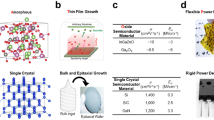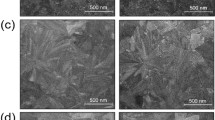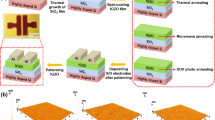Abstract
Thin-film transistors based on amorphous oxide semiconductors could be used to create low-cost backplane technology for large flat-panel displays. However, a trade-off between mobility and stability has limited the ability of such devices to replace current polycrystalline silicon technologies. Here we show that the sensitivity of amorphous oxide semiconductors to externally introduced impurities and defects is determined by the location of the conduction-band minimum and the relevant doping ability. Using bilayer-structured thin-film transistors, we identify the exact charge-trapping position under bias stress, which shows that the Fermi-level shift in the active layer can occur via electron donation from carbon-monoxide-related impurities. This mechanism is highly dependent on the location of the conduction-band minimum and explains why carbon-monoxide-related impurities greatly affect the stability of high-mobility indium tin zinc oxide transistors but not that of low-mobility indium gallium zinc oxide transistors. Based on these insights, we develop indium tin zinc oxide transistors with mobilities of 70 cm2 (V s)–1 and low threshold voltage shifts of –0.02 V and 0.12 V under negative- and positive-bias temperature stress, respectively.
This is a preview of subscription content, access via your institution
Access options
Access Nature and 54 other Nature Portfolio journals
Get Nature+, our best-value online-access subscription
$29.99 / 30 days
cancel any time
Subscribe to this journal
Receive 12 digital issues and online access to articles
$119.00 per year
only $9.92 per issue
Buy this article
- Purchase on Springer Link
- Instant access to full article PDF
Prices may be subject to local taxes which are calculated during checkout






Similar content being viewed by others
Data availability
The datasets analysed in this study are available from the corresponding authors upon reasonable request.
References
Nomura, K. et al. Room-temperature fabrication of transparent flexible thin-film transistors using amorphous oxide semiconductors. Nature 432, 488–492 (2004).
Song, J. H., Kim, K. S., Mo, Y. G., Choi, R. & Jeong, J. K. Achieving high field-effect mobility exceeding 50 cm2/Vs in In-Zn-Sn-O thin-film transistors. IEEE Electron Device Lett. 35, 853–855 (2014).
Yu, M. J., Lin, R. P., Chang, Y. H. & Hou, T. H. High-voltage amorphous InGaZnO TFT with Al2O3 high-k dielectric for low-temperature monolithic 3-D integration. IEEE Trans. Electron Devices 63, 3944–3949 (2016).
Jeon, S. et al. Nanometer-scale oxide thin film transistor with potential for high-density image sensor applications. ACS Appl. Mater. Interfaces 3, 1–6 (2011).
Jeon, S. et al. High performance bilayer oxide transistor for gate driver circuitry implemented on power electronic devices. In 2012 Symposium on VLSI Technology (VLSIT) 125–126 (IEEE, 2012).
Jun, T., Kim, J., Sasase, M. & Hosono, H. Material design of p-type transparent amorphous semiconductor, Cu–Sn–I. Adv. Mater. 30, 1706573 (2018).
Jeong, J. K. Photo-bias instability of metal oxide thin film transistors for advanced active matrix displays. J. Mater. Res. 28, 2071–2084 (2013).
Hosono, H. Exploring electro-active functionality of transparent oxide materials. Jpn. J. Appl. Phys. 52, 090001 (2013).
Kang, Y. et al. Hydrogen bistability as the origin of photo-bias-thermal instabilities in amorphous oxide semiconductors. Adv. Electron. Mater. 1, 1400006 (2015).
Bang, J., Matsuishi, S. & Hosono, H. Hydrogen anion and subgap states in amorphous In–Ga–Zn–O thin films for TFT applications. Appl. Phys. Lett. 110, 232105 (2017).
Kim, J. et al. Ultrawide bandgap amorphous oxide semiconductor, Ga–Zn–O. Thin Solid Films 614, 84–89 (2016).
Kim, J. et al. Conversion of an ultra-wide bandgap amorphous oxide insulator to a semiconductor. NPG Asia Mater. 9, e359 (2017).
Naumkin, A. V., Kraut-Vass, A., Gaarenstroom, S. W. and Powell, C. J. NIST X-ray Photoelectron Spectroscopy Database.
Korusenko, P. M. et al. Formation of tin-tin oxide core–shell nanoparticles in the composite SnO2−x/nitrogen-doped carbon nanotubes by pulsed ion beam irradiation. Nucl. Instrum. Meth. B 394, 37–43 (2017).
Zhang, X. et al. ‘Butterfly effect’ in CuO/graphene composite nanosheets: a small interfacial adjustment triggers big changes in electronic structure and Li-ion storage performance. ACS Appl. Mater. Interfaces 6, 17236–17244 (2014).
Yiliguma, Z. et al. Sub-5 nm SnO2 chemically coupled hollow carbon spheres for efficient electrocatalytic CO2 reduction. J. Mater. Chem. A 6, 20121–20127 (2018).
Mahmoodinezhad, A. et al. Low-temperature growth of gallium oxide thin films by plasma-enhanced atomic layer deposition. J. Vac. Sci. Technol. A 38, 022404 (2020).
Zhu, C., Osherov, A. & Panzer, M. J. Surface chemistry of electrodeposited Cu2O films studied by XPS. Electrochim. Acta 111, 771–778 (2013).
Gonzalez-Elipe, A. R., Espinos, J. P., Fernandez, A. & Munuera, G. XPS study of the surface carbonation/hydroxylation state of metal oxides. Appl. Surf. Sci. 45, 103–108 (1990).
García, V., Fernández, J. J., Ruíz, W., Mondragón, F. & Moreno, A. Effect of MgO addition on the basicity of Ni/ZrO2 and on its catalytic activity in carbon dioxide reforming of methane. Catal. Commun. 11, 240–246 (2009).
Kim, W. G. et al. High-pressure gas activation for amorphous indium-gallium-zinc-oxide thin-film transistors at 100 °C. Sci. Rep. 6, 23039 (2016).
Zhong, W., Yao, R., Chen, Z., Lan, L. & Chen, R. Self-assembled monolayers (SAMs)/Al2O3 double layer passivated InSnZnO thin-film transistor. IEEE Access 8, 101834–101839 (2020).
Hong, S. et al. Low-temperature fabrication of an HfO2 passivation layer for amorphous indium-gallium-zinc oxide thin film transistors using a solution process. Sci. Rep. 7, 16265 (2017).
Doll, T., Velasco-Velez, J. J., Rosenthal, D., Avila, J. & Fuenzalida, V. Direct observation of the electroadsorptive effect on ultrathin films for microsensor and catalytic-surface control. ChemPhysChem 14, 2505–2510 (2013).
Singh, N., Yan, C. & Lee, P. S. Room temperature CO gas sensing using Zn-doped In2O3 single nanowire field effect transistors. Sens. Actuators B Chem. 150, 19–24 (2010).
Zhang, Y., Cui, S., Chang, J., Ocola, L. E. & Chen, J. Highly sensitive room temperature carbon monoxide detection using SnO2 nanoparticle-decorated semiconducting single-walled carbon nanotubes. Nanotechnology 24, 025503 (2013).
Kuang, Q. et al. Enhancing the photon- and gas-sensing properties of a single SnO2 nanowire based nanodevice by nanoparticle surface functionalization. J. Phys. Chem. C 112, 11539–11544 (2008).
Velasco-Velez, J. J. et al. CMOS-compatible nanoscale gas-sensor based on field effect. Phys. Stat. Sol. (a) 206, 474–483 (2009).
Wolkenstein, T. The Electron Theory of Catalysis on Semiconductors (Oxford, 1963).
Wang, C., Yin, L., Zhang, L., Xiang, D. & Gao, R. Metal oxide gas sensors: sensitivity and influencing factors. Sensors 10, 2088–2106 (2010).
Harrison, M. & Willett, P. The mechanism of operation of tin(iv) oxide carbon monoxide sensors. Nature 332, 337–339 (1988).
Geistlinger, H. Electron theory of thin-film gas sensors. Sens. Actuators B Chem. 17, 47–60 (1993).
Nakamura, N., Kim, J. & Hosono, H. Material design of transparent oxide semiconductors for organic electronics: why do zinc silicate thin films have exceptional properties? Adv. Electron. Mater. 4, 1700352 (2018).
Ide, K. et al. Effects of excess oxygen on operation characteristics of amorphous In-Ga-Zn-O thin-film transistors. Appl. Phys. Lett. 99, 093507 (2011).
Nomura, K., Kamiya, T. & Hosono, H. Stability and high-frequency operation of amorphous In-Ga-Zn-O thin-film transistors with various passivation layers. Thin Solid Films 520, 3778–3782 (2012).
Nomura, K. et al. Subgap states in transparent amorphous oxide semiconductor, In–Ga–Zn–O, observed by bulk sensitive x-ray photoelectron spectroscopy. Appl. Phys. Lett. 92, 202117 (2008).
Nomura, K. et al. Depth analysis of subgap electronic states in amorphous oxide semiconductor, a-In-Ga-Zn-O, studied by hard x-ray photoelectron spectroscopy. J. Appl. Phys. 109, 073726 (2011).
Kim, J., Bang, J., Nakamura, N. & Hosono, H. Ultra-wide bandgap amorphous oxide semiconductors for NBIS-free thin-film transistors. APL Mater. 7, 022501 (2019).
Zschieschang, U., Weitz, R. T., Kern, K. & Klauk, H. Bias stress effect in low-voltage organic thin-film transistors. Appl. Phys. A 95, 139–145 (2009).
Lin, Y. H. et al. Hybrid organic–metal oxide multilayer channel transistors with high operational stability. Nat. Electron. 2, 587–595 (2019).
Chang, Y. H., Yu, M. J., Lin, R. P., Hsu, C. P. & Hou, T. H. Abnormal positive bias stress instability of In–Ga–Zn–O thin-film transistors with low-temperature Al2O3 gate dielectric. Appl. Phys. Lett. 108, 033502 (2016).
Shin, J. H. et al. Light effects on the bias stability of transparent ZnO thin film transistors. ETRI J. 31, 62–64 (2009).
Yoon, S. J., Seong, N. J., Choi, K., Shin, W. C. & Yoon, S. M. Investigations on the bias temperature stabilities of oxide thin film transistors using In–Ga–Zn–O channels prepared by atomic layer deposition. RSC Adv. 8, 25014–25020 (2018).
Hong, W., Oh, D. S. & Choi, S. Y. Passivation layer effect on the positive bias temperature instability of molybdenum disulfide thin film transistors. J. Inf. Disp. 22, 13–19 (2021).
Park, S., Cho, E. N. & Yun, I. Threshold voltage shift prediction for gate bias stress on amorphous InGaZnO thin film transistors. Microelectron. Reliab. 52, 2215–2219 (2012).
Zhou, F., Chiang, T. H. and Wager, J. F. Stretched-exponential trends in a-IGZO TFTs. Meet. Abstr. MA2016-02, 2142 (2016).
Zhou, F., Chiang, T. H. & Wager, J. F. Kinetics of response of ZnO-Ag ceramics for resistive gas sensor to the impact of methane, and its analysis using a stretched exponential function. Sens. Actuators B Chem. 255, 1680–1686 (2018).
Abe, K., Ota, K. & Kuwagaki, T. Device modeling of amorphous oxide semiconductor TFTs. Jpn. J. Appl. Phys. 58, 090505 (2019).
Acknowledgements
This work was supported by a grant from the MEXT Element Strategy Initiative: To Form Core Research Centers (no. JPMXP0112101001).
Author information
Authors and Affiliations
Contributions
H.H. and J.K. supervised the project. Y.-S.S., K.S. and Y.S. fabricated and characterized the samples with support from J.K. M.S. performed the transmission electron microscopy observations. S.U. performed the HAXPES measurements and analyses. K.A. performed the device simulation and analyses. Y.-S.S. wrote the manuscript with contributions mainly from H.H. and J.K. All the authors have given their approval to the final version of the manuscript.
Corresponding authors
Ethics declarations
Competing interests
The authors declare no competing interests.
Additional information
Peer review information Nature Electronics thanks Sang-Hee Park and the other, anonymous, reviewer(s) for their contribution to the peer review of this work.
Publisher’s note Springer Nature remains neutral with regard to jurisdictional claims in published maps and institutional affiliations.
Supplementary information
Supplementary Information
Supplementary Figs. 1–18 and Tables 1 and 2.
Rights and permissions
About this article
Cite this article
Shiah, YS., Sim, K., Shi, Y. et al. Mobility–stability trade-off in oxide thin-film transistors. Nat Electron 4, 800–807 (2021). https://doi.org/10.1038/s41928-021-00671-0
Received:
Accepted:
Published:
Issue Date:
DOI: https://doi.org/10.1038/s41928-021-00671-0
This article is cited by
-
High-speed emerging memories for AI hardware accelerators
Nature Reviews Electrical Engineering (2024)
-
High-performance metal halide perovskite transistors
Nature Electronics (2023)
-
Tin perovskite transistors and complementary circuits based on A-site cation engineering
Nature Electronics (2023)
-
Thin-film transistors for large-area electronics
Nature Electronics (2023)
-
Enhanced performance and stability in InGaZnO NIR phototransistors with alumina-infilled quantum dot solid
Scientific Reports (2022)



